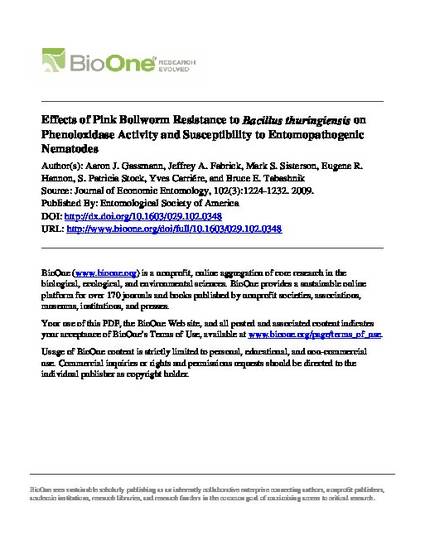
Widespread planting of crops genetically engineered to produce insecticidal toxins from the bacterium Bacillus thuringiensis (Bt) imposes selection on many key agricultural pests to evolve resistance to Bt. Fitness costs can slow the evolution of Bt resistance. We examined effects of entomopathogenic nematodes on fitness costs of Bt resistance in the pink bollworm,Pectinophora gossypiella (Saunders) (Lepidoptera: Gelechiidae), a major pest of cotton,Gossypium hirsutum L., in the southwestern United States that is currently controlled by transgenic cotton that produces Bt toxin Cry1Ac. We tested whether the entomopathogenic nematodes Steinernema riobrave Cabanillas, Poinar, and Raulston (Rhabditida: Steinernematidae) and Heterorhabditis bacteriophora Poinar (Rhabditida: Heterorhabditidae) affected fitness costs of resistance to Cry1Ac in two laboratory-selected hybrid strains of pink bollworm reared on non-Bt cotton bolls. The nematode S. riobrave imposed a recessive fitness cost for one strain, and H. bacteriophora imposed a fitness cost affecting heterozygous resistant individuals for the other strain. Activity of phenoloxidase, an important component of insects' immune response, did not differ between Bt-resistant and Bt-susceptible families. This suggests phenoloxidase does not affect susceptibility to entomopathogenic nematodes in Bt-resistant pink bollworm. Additionally, phenoloxidase activity does not contribute to Bt resistance, as has been found in some species. We conclude that other mechanisms cause higher nematode-imposed mortality for pink bollworm with Bt resistance genes. Incorporation of nematode-imposed fitness costs into a spatially explicit simulation model suggests that entomopathogenic nematodes in non-Bt refuges could delay resistance by pink bollworm to Bt cotton.
Available at: http://works.bepress.com/aaron_gassmann/41/

This article is from Journal of Economic Entomology 102 (2009): 1224, doi:10.1603/029.102.0348.